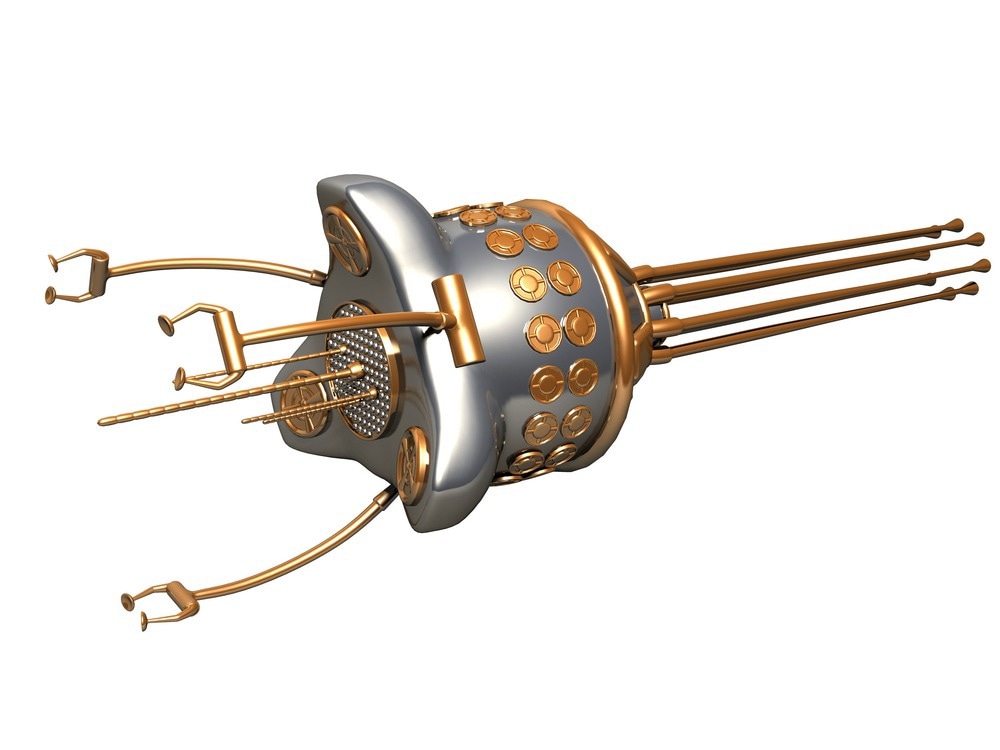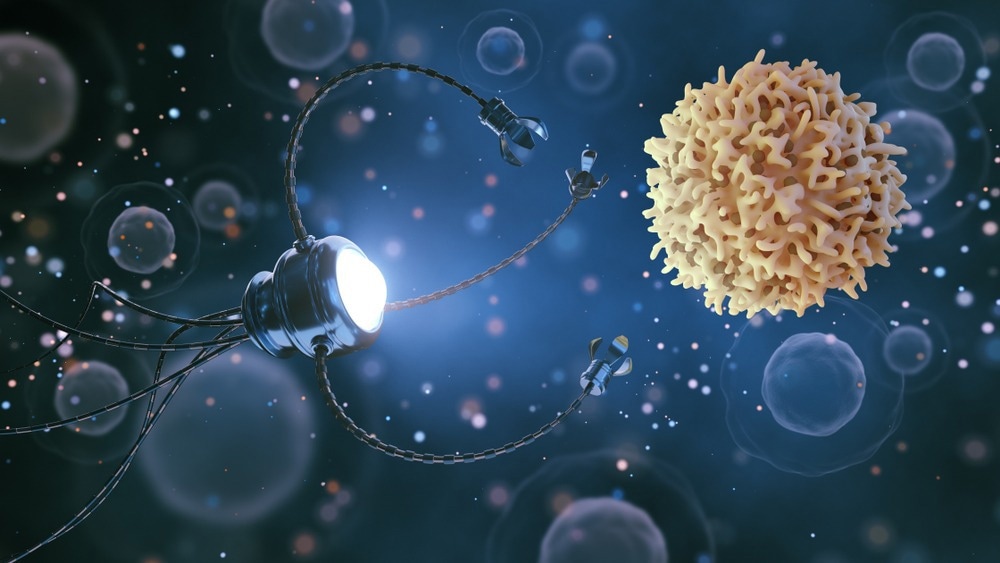Nanotechnology is among the fastest-growing technical disciplines, with a market value of $1 trillion and a projected growth rate of almost 20% within the next decade. Nanobots are an important component of that growth, yet, one of the most difficult obstacles in developing an efficient nanobot that can travel within the human body is the obstacle of effectively powering it.

Image Credit: Evgeniy Mahnyov/Shutterstock.com
Nanobots, due to their nanoscale, require an equally small yet powerful energy source. Several hypothesized power sources for nanobots are either naturally present inside the human body or must be provided from the outside. However, almost all energy sources have certain obstacles that must be overcome if they are to be utilized in nanobot propulsion.
Nanobots – When Nanotechnology and Robotics Come Together
Robotics and nanotechnology are ever-growing technologies affecting human lives more and more every day with advancements in fields such as life sciences and medicine. Nanobiotechnology adds a new dimension by combining robotics and nanotechnology with biology, creating nanorobotic systems, also known as 'nanobots'.
Nanobots are nanosized robotic systems that can perform specified tasks and are especially suitable for drug delivery. Typically, therapies pass through the whole body before reaching the target location. Nanobots help to improve the target accuracy of treatments, reducing the possibility of adverse side and off-target effects.
Industrial Relevance of Nanobots
The accurate and effective delivery of medicinal doses to target regions within the human body, especially confined locations, is challenging for passive drug delivery systems. Over the last decade, there has been a surge in the creation of proactive smart medication delivery devices that use external field-driven nanomotors.
Nanosized robots capable of accurately creating holes in specific cell membranes to destroy aberrant cells and even administering different medications are potential possibilities for noninvasive surgery.
Under the influence of a magnetic field, nanobots can drill into aberrant tissue and perform a specified task. The drilling function may be used to precisely enter the tissue, which holds tremendous potential for performing untethered surgeries.
Powering Nanobots – What Sources are There?
Nanobots require energy to function. To supply this energy, experts are looking at several different techniques. These techniques fall under two distinct categories, namely, external and internal.
Generators are prime examples of internal power sources. Generators aboard the nanobot could create energy either by utilizing electrolytes within the bloodstream or by using the surrounding bloodstream as a catalyst for a chemical reaction that generates energy when mixed with a chemical present within the nanobot.
In terms of external power sources, very tiny, thin wires can be used to connect the nanobots to an external power source. These wires can be composed of nanosized fiber optics, with light pulses being sent through the wires to generate power for the nanobot.
Magnetic fields and ultrasonic sounds are two alternative external power sources. A piezoelectric effect-based membrane capable of absorbing ultrasonic vibrations and converting them into electrical power can be used by nanobots for energy.
Magnetic fields may be utilized to accelerate electrical currents inside the robot's closed conducting loop. As an added advantage, the magnetic field can be utilized to steer the nanobot.

Image Credit: K_E_N/Shutterstock.com
Why the Need for Different Sources of Powering Nanobots?
Scientists in the field of nanotechnology are studying both internal and external sources of power for nanobots. Some ideas depend on the nanobots producing electricity from the person's body.
Other concepts involve a tiny power source built into the nanobots. Finally, some systems power the nanobots using field forces outside the person's body.
The search for an optimal method of powering nanobots drives the search for new and effective power sources. Each different power source has its advantages and disadvantages, promoting the utilization of various methods of powering the nanobots.
A nanobot, for example, might utilize the person's body heat to generate electricity efficiently, but this technology needs a temperature gradient inside the body to effectively control it, which is a challenging feat.
Another option for nanobot propulsion is to employ nuclear energy. This is an exciting option, yet people are scared about the idea of a tiny robot within the human body driven by nuclear energy. However, the quantity of the nuclear material is modest and, according to various experts, it is possible to protect the body from any harmful radiation.
Nevertheless, public sentiment toward nuclear power is highly unfavorable, fueling the hunt for an ideal power source.
Challenges of Various Nanobot Power Sources
Powering nanobots can be performed in various ways, each with its own obstacles. Chemically driven nanobots, for instance, are quicker than nanobots powered through other methods, but their movement lacks directionality.
Furthermore, they need harmful fuels to operate. In contrast, external field-powered nanobots do not require such harmful fuels for power, yet their movement is somewhat sluggish.
Lightly powered nanobots may be able to move in water, but their dependability on their chemical composition jeopardizes their biocompatibility. On the contrary, nanobots powered by ultrasonic waves are highly biocompatible, yet do not possess directionality control, making it challenging for them to accomplish specified tasks.
Finally, although nanobots powered through an electric field are highly promising, the biological applicability of such a method is currently restricted and has yet to be thoroughly established.
Magnetic field-driven nanobots are the up-and-coming series of nanobots, overcoming the majority of drawbacks associated with other nanobot-powering techniques. They have already been deployed in numerous biomedical and environmental applications, making them ideal for powering nanobots.
References and Further Reading
Zhou, H., et al. (2021). Magnetically Driven Micro and Nanorobots. Chemical Reviews. https://doi.org/10.1021/acs.chemrev.0c01234.
Guatam, G., et al. (2021). A Brief Review on Challenges in Design and Development of Nanorobots for Medical Applications. Applied Sciences. https://doi.org/10.3390/app112110385 .
Berger, M. (2021). What Are Nanobots? Nano Werk. Available at: https://www.nanowerk.com/what-are-nanobots.php (Accessed on 22 November 2022)
Nelson, D. (2020). What are Nanobots? Understanding Nanobot Structure, Operation, and Uses. Available at: https://www.unite.ai/what-are-nanobots-understanding-nanobot-structure-operation-and-uses (Accessed on 26 November 2022)
Disclaimer: The views expressed here are those of the author expressed in their private capacity and do not necessarily represent the views of AZoM.com Limited T/A AZoNetwork the owner and operator of this website. This disclaimer forms part of the Terms and conditions of use of this website.